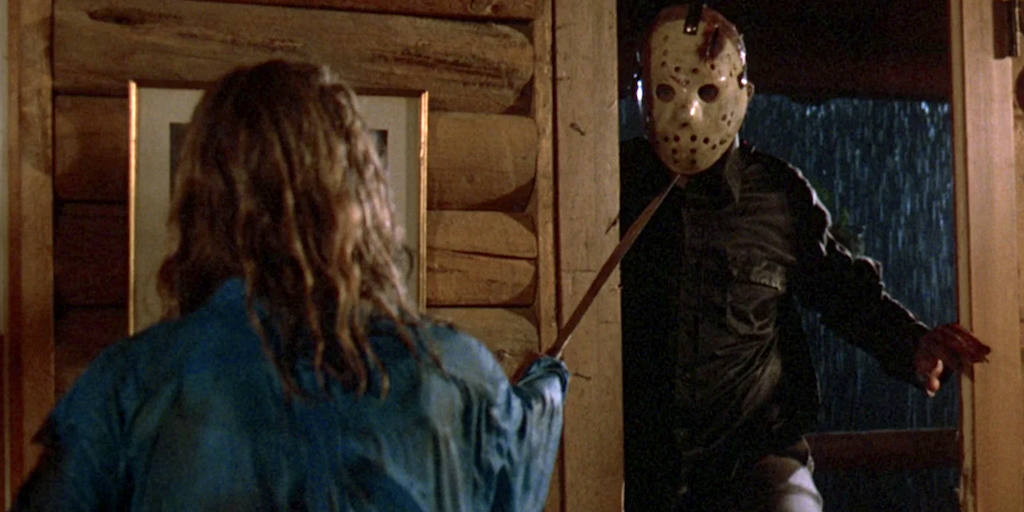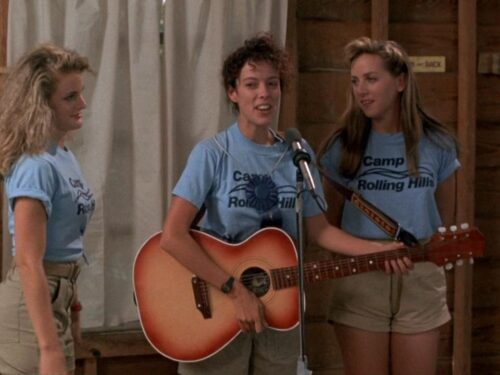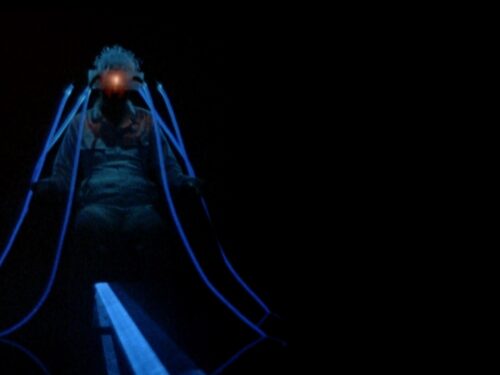Critics typically grouse about the gratuitous violence of Friday the 13th films, while ignoring the more thrilling gratuity of each new chapter’s very existence. Spencer Parsons explores the self-justifying absurdity of Jason Voorhees’ evolution as a franchise star
Would you be yourself if you looked like this?
Let’s start with the hockey mask, even though the movies didn’t. No, let’s start there especially because the movies didn’t. The fact is, the filmmakers needed to show more than Jason’s feet, his hands, his shadow after a certain point in the mayhem. Those gimmicks wear out their welcome, and they couldn’t exclusively represent him via first-person stalker-cam without deranging the staging and compromising the gore effects the audience came for. The filmmakers hated the baghead look they’d had to use in the previous chapter, for lack of a better idea. They wanted something, anything else to cover his face. They put that hockey mask on Jason because “no one really wanted to do the makeup.”
At least that’s what Martin Jay Sadoff, the 3D supervisor for Friday the 13th Part 3 (1982) has claimed in interviews. He maintains that under the gun to camera test Jason’s look in 3D, special effects head Martin Becker suggested, “Well, we don’t have anything, so let’s put a goalie mask on him.” Conveniently enough, hockey fan Sadoff happened to have “my big red hockey bag with me, and I pulled a mask out.” Costumer Sandi Love speculates they chose the goalie mask because there were so many Canadians on the crew. Executive Producer Frank Mancuso, Jr. scarcely remembers the choice. “I just remember looking at a bunch of tests of different masks and deciding on which one we should go with.” Associate Producer Peter Schindler avers that “it probably was everybody’s idea, and everybody wants the credit, but it was nobody in particular.” Ironically, Sadoff claims the most individual credit of anyone in Peter M. Bracke’s gargantuan oral history, Crystal Lake Memories (2005), yet also insists, “it was never even meant to be a hockey mask in the first place. It was never going to be that.”
But there had to be a mask. No cut-rate production schedule could afford for each of his scenes to commit an actor or stuntman to hours in the makeup chair as a whole department shaped his face with lumps of latex to achieve Jason’s trademark look of hydrocephalic cubism. So they contrived for Jason to pilfer a simple mask from one of his victims: big-haired, unfuckable Shelly (Larry Zerner), Part 3’s resident prankster dweeb, whose love language is the jump scare. Shelly dons a wet suit and hockey mask to brandish a harpoon gun at nonplussed Vera (Catherine Parks), who charitably calls him a jerk. Shelly replies, “Being a jerk is better than being a nothing.” She tells him he’s not a jerk, a reply not so comforting as it sounds. Skulking away, Shelly downshifts from acting out to self-loathing, only for Jason to choose “jerk” and murder him.
Then, Jason uses the mask to trick Vera into thinking he’s Shelly for just long enough to properly aim his harpoon and put it right in her eye. Inexplicably, but much to the line producer’s relief, Jason sticks with the look for pretty much the rest of the movie.
As if by automatic writing, the filmmakers unconsciously produce the franchise’s signature image. Formally, they evidence no awareness of what they have wrought: when Jason at last becomes Jason, the camera fails to push in for emphasis; the score fails to swell. Nothing “iconic” heralds the arrival of an icon that happened to be lying around.
Randomness lends crude realism, but more importantly, and blessedly, the mask signifies nothing. They could easily have grabbed a monster mask from Shelly’s bag of tricks, but the conceit would have stunk of rationality and looked the wrong kind of silly. In fact, a rubber werewolf mask from Shelly’s collection does get dropped on a staircase and stays for some time, repeatedly threatening to slip underfoot like some hirsute banana peel, drawing focus like a bad extra. Perversely, the werewolf receives more care and attention than the goalie mask, only to remain clutter, not an inscrutable talisman from a future of recurring dreams.
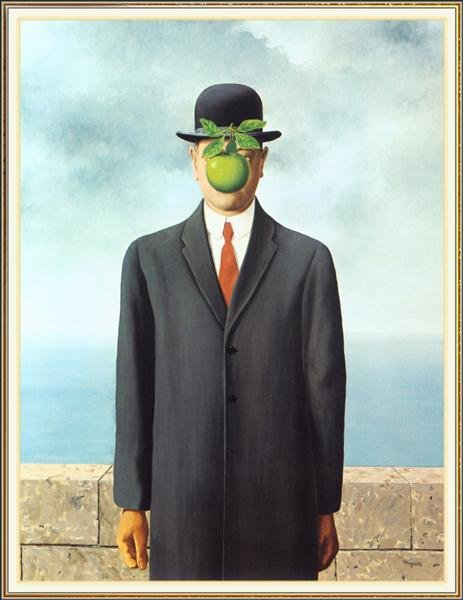
Throughout the latter part of his career, conjecture about the meaning of an apple followed René Magritte like a bad penny. You know the one: that floating, green apple frustrating the view of Magritte’s own face in a self-portrait titled “The Son of Man.” “If one looks at a thing with the intention of trying to discover what it means,” he explained on one occasion, “one ends up no longer seeing the thing itself, but of thinking of the question that is raised.” So why a hockey mask with a wetsuit? Why is California doubling as New Jersey? Would the answers stick in the mind or the meme like the mask in itself? Its power presses forward through all subsequent entries, but the hockey mask curiously extends backwards as well. To watch Part 3 now is to see Shelly put on his mask, and before you catch yourself, think “oh cool, he’s imitating Jason.”
Ma’am, we didn’t find any boy.
In his first manifesto, Andre Breton defined surrealism as “Psychic automatism in its pure state, by which one proposes to express… the actual functioning of thought, dictated by the thought in the absence of any control exercised by reason, exempt from any aesthetic or moral concern.” To be fair, he could have been describing independent film production, but for Friday the 13th movies, it goes double.
In an entertainment tradition predating both cinema and surrealism, the entire Friday the 13th series derives from the simplest IP imaginable: an ad in Variety. In block letters, the title floated over a void, appearing to break through glass. Below, a tagline threatens, “The Most Terrifying Film Ever Made! Available November 1979.” Like any capable sideshow barker, producer/director Sean Cunningham promised thrills and a show time, then worried over how to deliver characters, incidents and thrills. Meanwhile, the moneyed marks lined up.
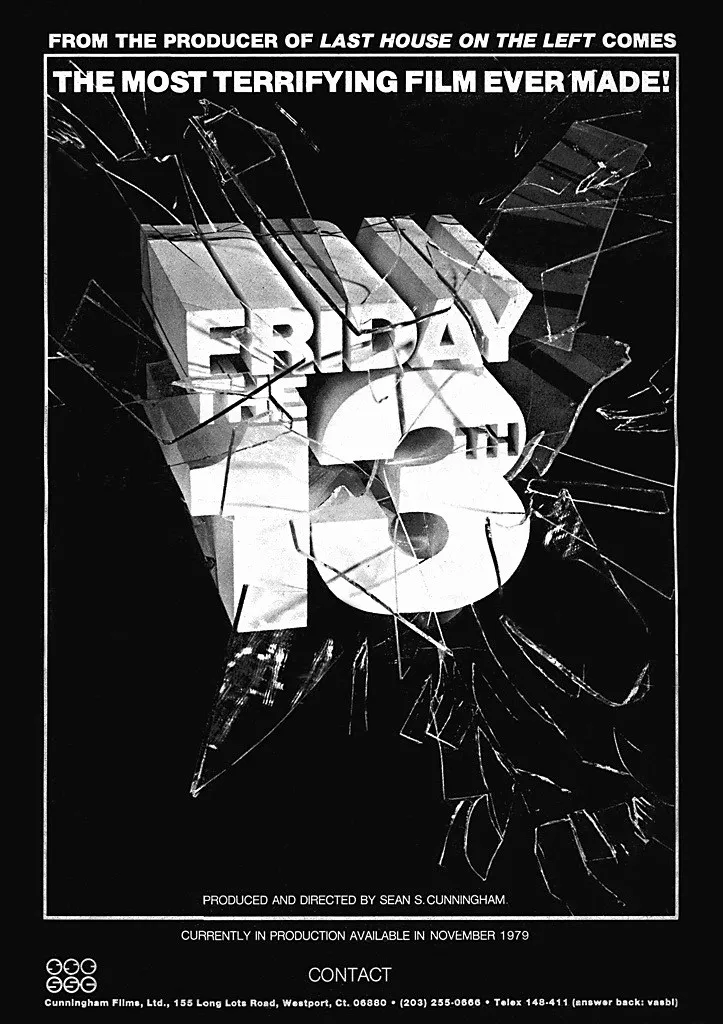
Treating the title as a holiday, he stole from Halloween, which itself borrowed the gag from Black Christmas (1974). A mysterious slasher would target a nubile array of counselors at Camp Crystal Lake on a bad luck Friday and untwist the ending of Psycho (1960). This time, it really was Mother: one Pamela Voorhees (Betsy Palmer), still shattered by the drowning of her special needs son, Jason, two decades before, when his unwatchful guardians stole away for a quickie. Revealed only near the end in a climactic spasm of Scooby-Doo dramaturgy, Mother Voorhees confesses to celebrating the anniversary of her son’s death by murdering a new generation of beer-drinking, pot-smoking, premarital-sex-having counselors.
The ending needed something. Tom Savini, the film’s makeup effects wizard suggested that after sole survivor Alice beheaded Mrs. Voorhees in self-defense, they should follow it with a final, show-stopping scare in shameless imitation of the hand thrusting up from the dead heroine’s grave at the end of Brian DePalma’s recent hit, Carrie (1976).
As Savini told it, “You think the movie is over: Amy Irving is walking to Carrie’s grave and the music is playing as if the credits are going to roll any second, then suddenly this hand pops out of the grave. That scared the piss out of everybody. So great, let’s do the same thing. But how are we going to do that here when everyone’s dead? So I said, ‘It might be psychologically disturbing if Jason suddenly pops out of the water and grabs her.’ Because you’ve kind of dismissed him, he’s gone, and then just have Alice wake up out of a dream. Which worked, because if it’s a dream, you can show anything and get away with it no matter how preposterous it is.”
So Alice awakens in the care of the film’s useless police, to arrive at a standard campfire story coda meant to rationalize it, but which instead muddies the waters:
Alice: The boy. Is he dead, too?
Officer Tierney: Who?
Alice: The boy. Jason.
Tierney: Jason?
Alice: In the lake, the one… the one who attacked me. The one who pulled me underneath the water.
Tierney: Ma’am, we didn’t find any boy.
Alice: But… then he’s still there.
“At the time Jason wasn’t a villain, he was just a figment of somebody’s imagination,” noted Cunningham. “Having Jason come up out of the lake was a device. It was justifiable, but it wasn’t meant to be the beginning of a story. He was just a gag.” A gag to get teen audiences to talk about it, to come back again, get their friends to see it on a dare. And they did. The kids dream of summer sex and mayhem, while filmmakers and financiers dream of money, and the money dreams of us.
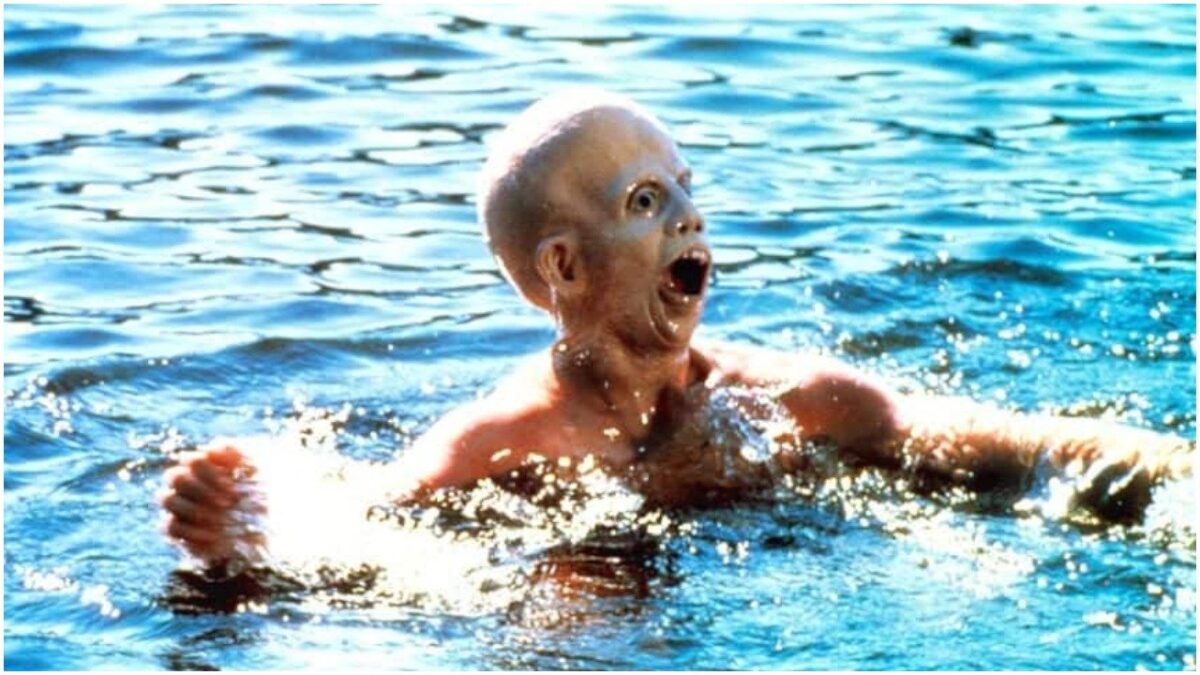
The financiers wanted a sequel, they wanted to graduate little Jason to the status of machete/axe/harpoon-wielding slasher, and they wouldn’t take no for an answer. Though Cunningham stayed on to produce sequels, he bowed out of writing and directing over Jason. Savini and screenwriter Victor Miller left the scene entirely, all three of them finding the concept utterly irrational and therefore a terrible idea. They were right about the irrationality, but like many dreamers, they awakened to miss the point of the dream.
Trapped by dark waters. There is no escape. Nor do we want it.
With no disrespect to the great and nasty little horror film they made, the departure of Cunningham, Savini, and Miller from Part 2 was the best thing that could happen to the ensuing franchise. No natural or intentional artistic process could create so sublimely misshapen a narrative over a dozen films, with a patchwork golem to match. Chaos reigned. Cooler heads did not prevail.
A card-carrying surrealist could scarcely devise a mode of artmaking madder than what emerged over the series from the frottage between financiers Georgetown Productions and Paramount Pictures rubbing against a gaggle of competing egos and, eventually, New Line Cinema’s herky-jerky quest to stage a battle royale between Jason and their own Freddy Krueger. Jason would not only manifest in multiple and contradictory forms, but find his way to Times Square, Elm Street, and outer space.
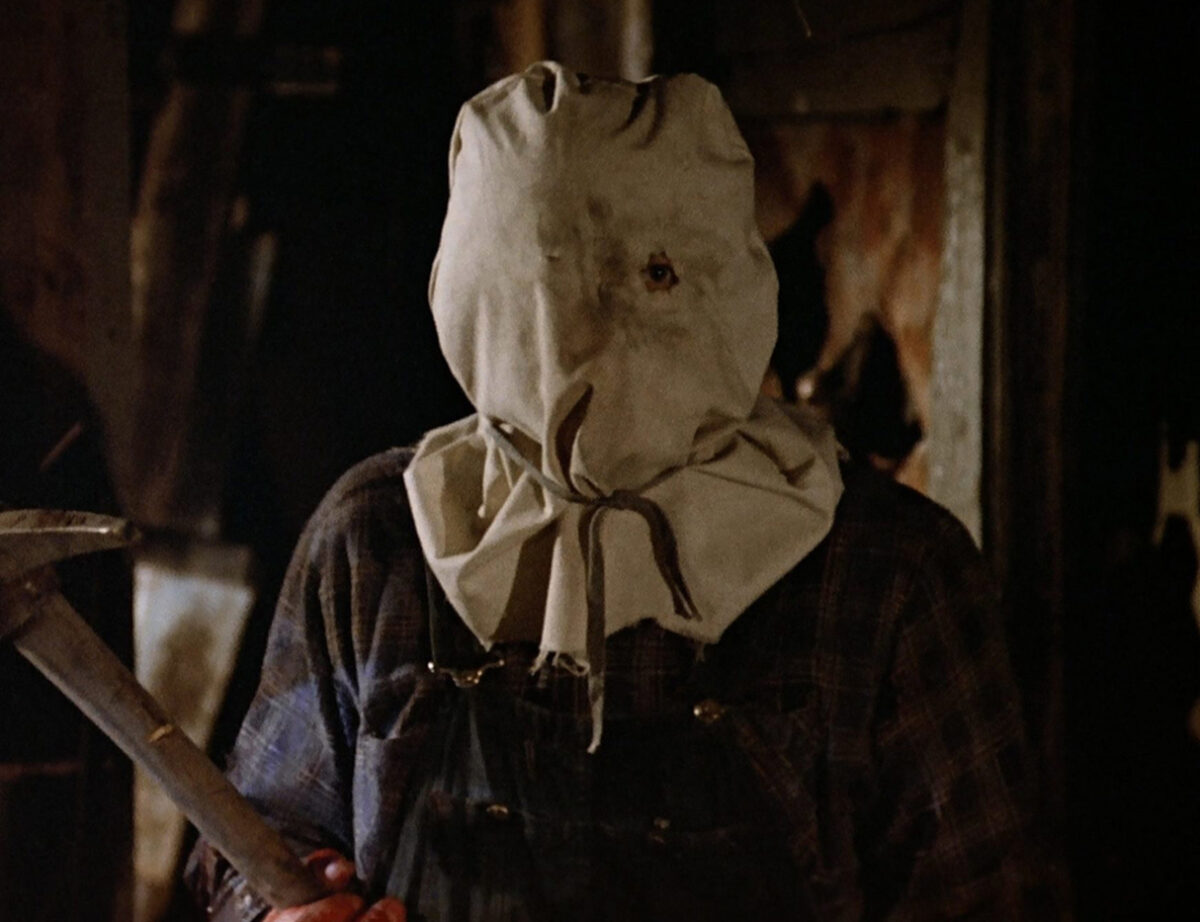
I will stop short of calling these films fully “surrealist.” They’re generated from a pursuit of filthy lucre rather than a liberatory program of psychological confrontations intended to free individual minds from societal constraints and connect to a deeper social stream (and for Andre Breton, a socialist purpose). Sometimes, however, capital falls asleep at the switch. In a single film, a psychologically disruptive mode of production might produce accidental surrealism, but over the chaotic emergence of several sequels, we may chance upon what I propose to call “franchise surrealism.”
Franchise surrealism constitutes a mode of cultural production guided chiefly by a profit motive that, in limiting the individual narrative, stylistic, and logical agency of all involved, taps into a collective irrationality and dreamlife over the course of multiple sequels that are at once connected by premise, character, and chronology, and disconnected or fractured by a lack of guiding plan or consistent personnel. Without sufficient deliberate intention to create formal unities, this mode stochastically generates the conditions of collage, automatic writing, exquisite corpse, and other surrealist methods that circumvent and frustrate conscious minds, while calling forth the variegated fauna of a collective unconscious.
While the narrative fibrillations of the Friday the 13th franchise suggested the concept to me, it can hardly be the only example. However, I would warn against applying franchise surrealism to just any film series, however capriciously constructed. Recent Star Wars entries, for example, have emerged from a legendary corporate shitshow. Certainly they tap into the chthonic, irrational forces of internet fandom, but is that enough? I hope not. Whatever chaos we may find in the increasingly impressive Chucky franchise, screenwriter and sometime director Don Mancini’s steady hand renders that series a distinctly auteurist phenomenon. I’m not feeling gatekeeper enough to preemptively turn away the Leprechaun movies, but to me, experiencing them together feels less actively surreal than like a succession of films made on a dare. This distinction suggests the most important quality of all: franchise surrealism obtains when the films function more successfully considered together, not in spite, but because of their brokenness and contradictions over their oneiric unfolding as a single narrative. Each makes the others more rewarding, to the point that quasi-intentional frissons and failures over a series redeems even the worst entries. Scratch a Friday the 13th fan, and if they have extremely negative feelings about, say, Friday the 13th Part VIII: Jason Takes Manhattan (1989), they have also seen it 50 times and may very likely own memorabilia from it. As Karl Marx wrote, capital “has acquired the occult ability to add value to itself. It brings forth living offspring, or at least lays golden eggs.”
I’ll have a Voorhees burger and a side of Jason fingers.
Critics typically grouse about the gratuitous violence in these films and willfully ignore the far more thrilling gratuity of each new chapter’s very existence. Like Jason himself, each film should not be, and yet here it is. From the first sequel, director Steve Miner adopts without question that the drowned boy has somehow survived to commence his own revenge rampage for the murder of his mother. Without a word of exposition, Miner has him walk into the opening shot. This bold move, created for money’s absurd and unreal demand, essentially builds upon the original and starts over from scratch at the same time.
At the end of the film, Miner then stages Jason’s apparent death and re-resurrection with maximum unreliability, to the degree that even he can’t be sure who lived and who died. Miner’s commentary reveals this narrative illegibility to be a happy accident of production and editing that neither forecloses nor sets up a sequel. The third chapter naturally begins with a recap that clarifies almost nothing as it sets new mayhem into motion. Breton might as well have been offering script notes when he wrote that, “Memory alone arrogates to itself the right to excerpt from dreams, to ignore the transitions, and to depict for us rather a series of dreams than the dream itself.”
This and all the subsequent Friday conclusions pale in comparison to the icy chill and loneliness that linger after Black Christmas, or the screaming, cackling escape from both Leatherface and sanity that gasses up nightmares beyond The Texas Chain Saw Massacre’s (1974) hard stop. Yet the Friday the 13th series carries us with reasonable success from dream to dream on plaintively unanswered questions and eerie irresolution for seven films before a well-earned collapse into bathos and then burlesque. I make the unfair comparison by way of illustration. Black Christmas and The Texas Chain saw Massacre perversely depend upon their own completeness and sufficiency to generate their respective states of unresolvable alarm. Any sequel continuing the story of Black Christmas would wreck it. The Texas Chainsaw Massacre Part 2 (1986) plunges headlong into a broadly comic look and tone that sets the Sawyer family on new massacres in a new Texas. It’s not in the plot. It’s in the meat.
Admittedly, Friday the 13th endings range in effect from dread to diminuendo to disappointment, but the alternating current they create with the self-justifying absurdity in each new beginning animates this exquisite corpse. Typically, the first 10 minutes of any new entry connecting to the previous delivers a Battleship Potemkin of crazy, putting Jason in motion with whatever is lying around, be it electrical, psychological, telekinetic, parasitical, or what if Jason was in space? And whether taking the guise of baghead or hockey mask or uber Jason, whether becoming the deformed little boy from the lake once more, I count nine credited principal performers to play the role in the original 10 films, plus one each for Freddy vs. Jason (2003) and (ugh) the Platinum Dunes remake (2009).
Until Kane Hodder arrived in Part VII: The New Blood (1988), no Jason was hired back, out of cheapskate conviction and reckless disregard for acting. You can say it’s just a guy in a bag or a hockey mask, but each performance does something different, delivered with varying levels of thespian commitment. Include the crowd of non-repeating makeup effects artists, animatronics technicians, and randomly selected crew members to complete the onscreen body of Jason Voorhees, and he’s some kind of a Frankenstein.
Jason wanders the forest surrounding Crystal Lake, which itself meanders quite noticeably from shooting locations in New Jersey to southern California playing New Jersey, from Georgia swamps to Alabama bayous as the Garden State, before setting sail from a Vancouver refusing to play New Jersey, and on to the brain-melting failure of Vancouver-as-New York. Then blink and you’ll miss Jason stalking through the real Times Square. However ridiculous, the outer space of Jason X makes a lot more sense than Crystal Lake and its immediate environs in previous chapters. In parallel, the shambolic, juddering assemblage of plots and influences form a corpus that recapitulates the spliced-together star attraction navigating the fault lines and fissures of the locations budget.
On one level, this makes keeping up with the series wild, ridiculous fun, but the ways the films fall into dreaming one another produces more profound effects. To demonstrate how this works, and how the surrealism in these films cuts deeper than we might expect, allow me to follow one element of the mythology that recurs and develops over the series, most clearly represented by the Tommy Jarvis “trilogy” of parts 4, 5, and 6. But first we need to talk about Ginny.
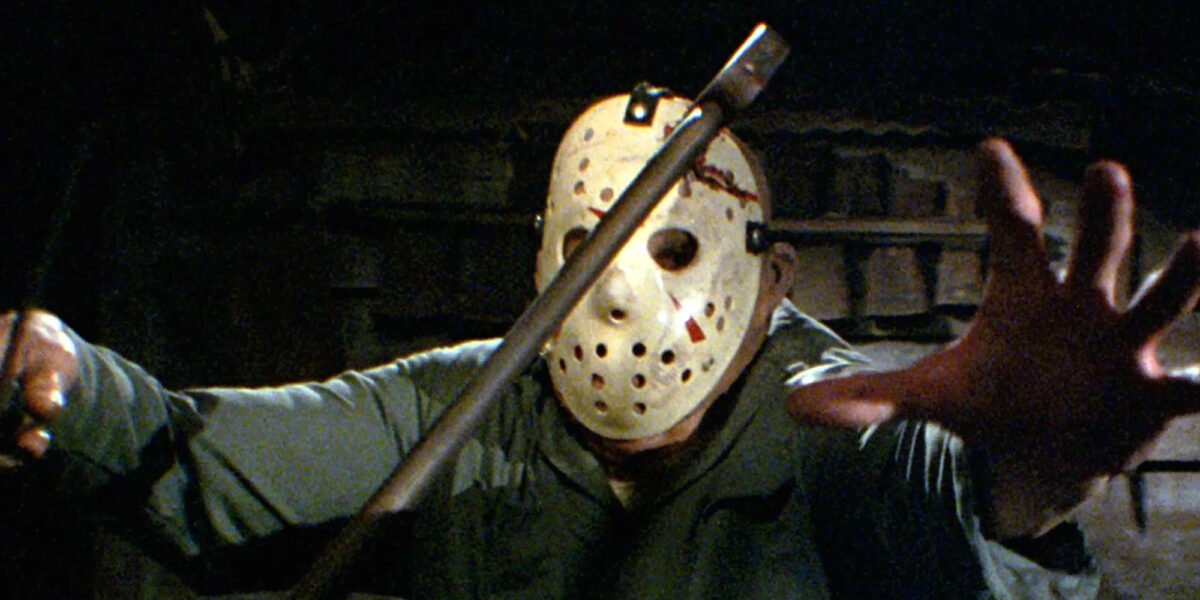
Some kind of boy or beast
It falls to Ginny (Amy Steel) in Part 2 to make sense of the senseless in what turns out to be the most important infodump in the series. “What if there is a Jason?” Ginny asks. “What if there is some kind of boy or beast running around Camp Crystal Lake? Let’s try to think beyond the legend, put it in real terms. What would he be like today? Some kind of out-of-control psychopath? A frightened retard? A child trapped in a man’s body? He’d be grown by now, right?” Let’s not forgive her the slur that tumbles out among the hypotheticals, accurate though it may be to some American speech in 1981. It strikes an appropriately discordant note coming from a character acknowledged as an aspiring child psychologist. Amy Steel delivers the word with compassion rather than venom, bringing doubleness as the schoolyard taunt still stings. Then she takes a turn:
“And you know the only person he knew was his mother? He never went to school, never had any friends. She was everything to him… I mean, I doubt Jason would have known the meaning of death. At least not until that horrible night. He must have seen his mother get killed. And all because she loved him. I mean, isn’t that what her revenge was all about? Her sense of loss, her sense of rage at what she thought happened. Her love for him? Bizarre, isn’t it? He must be out there crying for her to return. A resurrection.”
Amy Steel delivers all this with subtlety and directness, crafting a lovely moment at the center of an unlovely movie. Steel tells of her scene partners John Fury and Stuart Charno breaking take after take, laughing uproariously at “boy or beast,” with the ironic effect of increasing her conviction for the patently absurd, pressing harder for tenderness. The plot transmutes her melancholy conjecture into fact and then into mythology, when her compassionate empathy for monstrous Jason and Mrs. Voorhees gives her the key to a psychodrama that will allow her to… subdue and kill Jason. Heads up: that doubleness won’t quit.
Arriving at Jason’s patchwork shack in the forest that contains Jason’s shrine to his mother, Ginny instinctively grabs the cable knit turtleneck laid out next to Mrs. Voorhees’s severed head and pulls it on to inhabit the person of the style icon and original slasher. Through an apparent psychic communion with the first film, she simply knows to riff on mother’s own vocal channeling of drowned, baby Jason, “kill her, mommy!” Urging him to put down his pickaxe so that she can take him out with his machete, she intones, “It’s all done, Jason. You’ve done your job well, and Mommy is pleased… Listen to your mother!” The ghostly face of Betsy Palmer’s Mother Voorhees dissolves in over Ginny’s, courtesy of footage shot not by director Miner, but by friend-of-the-franchise Wes Craven.
When the box office demanded another sequel, Miner intended to begin the next chapter with Ginny in a mental institution, focusing on the traumatic after-effects of murderous self-defense. However, the Friday the 13th system of production thwarted continuity and traditional narrative development when financiers wouldn’t pony up sufficient funds to lure Amy Steel back for another round of insufficient artistic fulfillment.
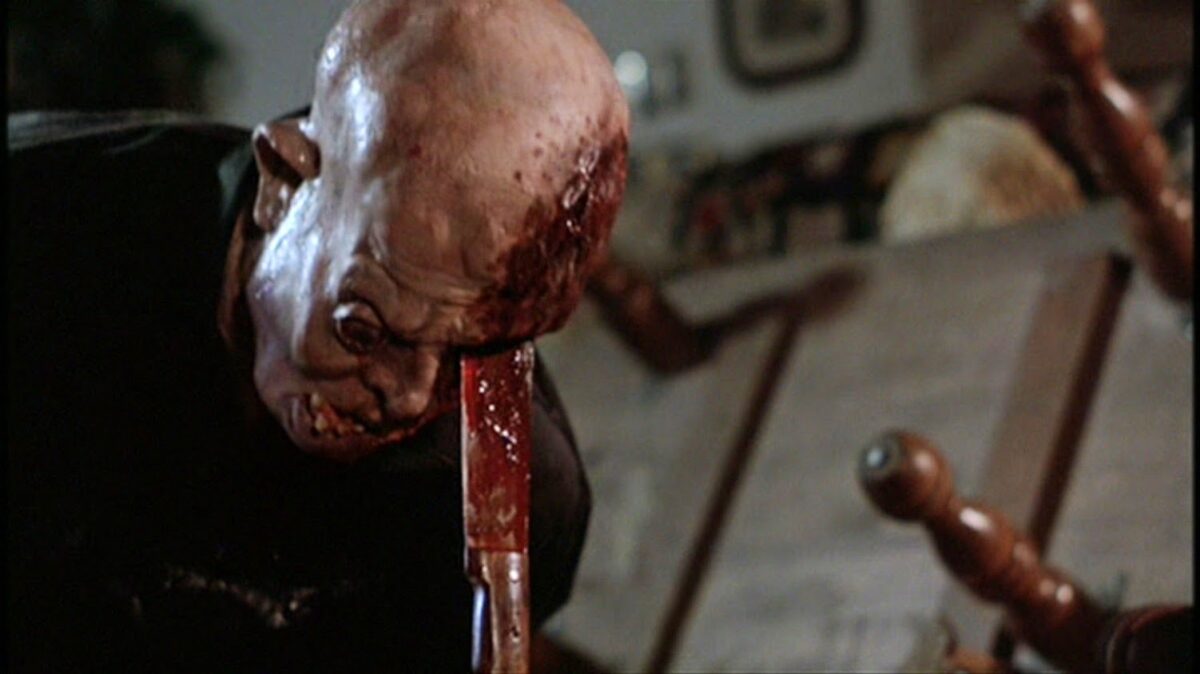
Die! Die! Die!
Cheapness and inattention continually vouchsafe the desperation of actors, writers, directors, and effects artists charged with keeping our Jason on the move. Against the critical canard that these movies are all the same (but some are worse), the filmmakers typically meet their audience not with simple repetition, but rather by remixing and reworking incidents and images into provocative recombinations and eerie echoes. In particular, without recurring characters to develop, or at least maintain relationships and objectives over the course of ensuing chapters, the new team of artists instead make do by reworking the thematic, interpersonal, and mythic dynamics among the archetypes available in past ensembles.
So, two entries after Ginny’s agon with Jason, in Friday the 13th: The Final Chapter (1984), 12-year-old Corey Feldman’s Tommy Jarvis takes her place in the narrative. Tommy works a variation on Ginny’s maternal confrontation to present Jason with his own double. Tommy shaves his own head to meet the monster in the guise of Jason’s own past self, the child who at once did and did not drown. This enables Tommy to murder Jason in as disturbing a fashion as Tom Savini could devise and the MPAA would allow.
Once again, characters seemingly intuit knowledge from previous entries in which they did not participate, rather than via exposition from a recurring character, as in the Final Destination series, for instance. While Tommy does discover a yellowing news clipping about the mayhem of Part 3, which tells Jason’s story alongside an artist’s rendition of the drowned child, planning to confront Jason as his double does not rationally follow. Moreover, in the “continuity” between the films, the events recounted in that newspaper story would have taken place less than 48 hours ago. Discovering the mass-murderer’s backstory and past appearance assumes an investigative journalist with a time machine. In a DVD commentary track, director Joseph Zito and screenwriter Barney Cohen both fess up to this impossibility, but admit since it putatively give Tommy the information needed (to work his riff on Ginny’s psychodrama), they couldn’t be bothered with series continuity. Thus, a rational explanation begets even greater irrationality.
Now, if Tommy echoes Ginny, he also recalls Shelly, with his masks and gags. As a child on the cusp of puberty, Tommy works through a more extreme variation on Shelly’s sexual frustration. He’s excited where Shelly had been glumly fixated on the hookups and skinny dipping around him, but Tommy also hits a much more decisive barrier to getting laid.
But the archetypal remixing won’t stop. Tommy also stands in for a young Tom Savini, coming back to conjure this entry’s illusions of violence and gore. He and his makeup crew donated their own gorgeous handiwork to play the collection of monster masks Tommy has created, marking the character as a true savant, if not a full-blown savior to the fallen world of Crystal Lake. We’re still not done with this most over-determined of all characters in the franchise: he also mirrors the young Fangoria subscribers in the audience who know Savini’s name and consider the makeup magician the film’s biggest star.
On his return to the creative team, Savini mused, “It made me feel like Dr. Frankenstein. I created the monster. And I get to kill him.” A nice thought, but it bears mention that in Universal’s Frankenstein films, the creature kept coming back anyway, and in Mary Shelley’s novel, the monster drives Dr. Frankenstein to an early grave. Had the series ended as promised and as Savini too reasonably expected with The Final Chapter, its rifts and contradictions would have created bizarre and dreamlike effects across a relatively balanced and shapely quartet of stories. After the pattern of the first three, the final death of Jason would have still resolved into unsettling ambiguity. The screen locks into a freeze frame on the manifestly disturbed eyes of Tommy Jarvis, invoking the trauma of killing in self-protection and suggesting a dark future for our hero. The rule was to end on a stinger, but this one carried an admirably sharper sting.
“We were told that part 4 was going to be the final chapter, as in no more Jason, no more Fridays, no more nothing,” attests director Joseph Zito. “As far as I’m concerned, we killed Jason.” But fans loved it, perhaps in part because they, too, believed it to be final. But once again, the box office returns demanded a sequel and unleashed forces that made the ongoing series much weirder.
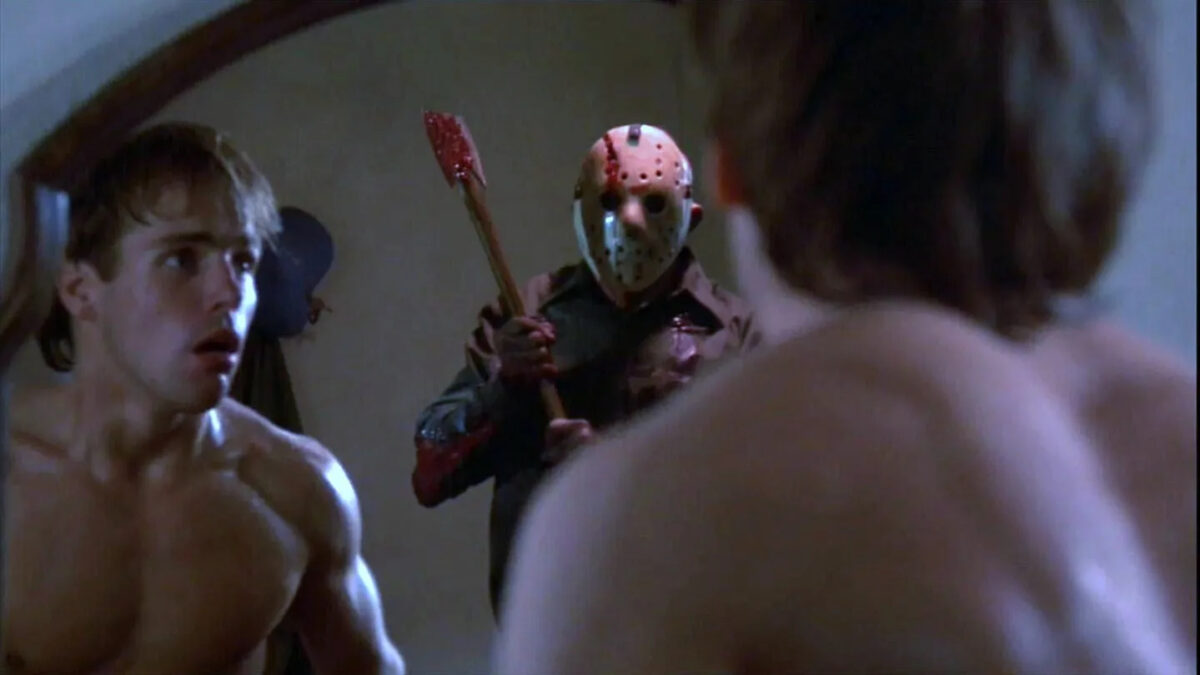
You’ve been out in the sun too long.
In 2019, filmmaker and Friday the 13th superfan Andrew Bujalski co-hosted a Terror Tuesday screening of Part V: A New Beginning (1985) at an Austin, Texas, Alamo Drafthouse, ”precisely because I was offended that their series had run all the others except Five. But Five is a wild game changer in which the moral rules of the game are rewritten and, no contest, features the most genuinely shocking murder in the series.”
Easily the most controversial chapter in the Friday the 13th saga, A New Beginning nevertheless functions as the franchise’s guilty, damaged centerpiece. In Crystal Lake Memories, interviewees badmouth it more than any other entry, waving A New Beginning like a bloody shirt to signal “what not to do with Jason.” Part VI attempted a full “reboot” (before that term was invented) to wash away the aftertaste of Part V, and as Bujalski mentions, retrospective programmers feel comfortable leaving it out. I won’t go as far as calling Part V the best (that would be Part 2), but it has proven the most fascinating and rewarding to revisit as a Friday maudit and a dark nexus of narrative potentialities in the original 10 entries (pre Elm Street or Platinum Dunes).
When Tommy Jarvis (now played by John Shepherd) awakens from uneasy dreams — a few years older and more shredded, plus a whole lot sweatier than Corey Feldman — he’s become the newest patient at the Pinehurst Halfway House, a sad sack, unwell double for old Camp Crystal Lake. We instantly sense something off. The new ensemble he joins scowls and shuffles and mutters insults where previous casts cavorted and grinned and joshed one another. The setting’s relationship to haunts in previous chapters works not unlike the dank, surly Deer Meadow that doubles cozy, familiar Twin Peaks in the opening sequence of Fire Walk with Me (1992).
Director Danny Steinman lets performers make dangerously big choices — screeching, stammering, shuddering, and sulking cartoonishly through their various states of psychological duress. Where local cops previously have maintained a standard of well-meaning incompetence, here they hover malevolently and threaten to shut down this minor mental health facility on behalf of floridly white trash NIMBY neighbors. The lighting takes on the garish color palette of a mid-’80s straight-to-cable genre product, and wide angle closeups push actors into service as gargoyles. Bad vibes ooze from the screen nonstop, even before a terrifyingly undermotivated axe murder of a patient that looks alarmingly like Shelly by another who somewhat resembles our new Tommy. In Jason’s absence, evil is everywhere.
You may have noticed we’ve landed in the scrapped Part 3 scenario that would have continued with Ginny, wallowing in the grief and trauma only briefly acknowledged, or mostly repressed, in previous chapters. While the narrative returns to the original Friday’s murder mystery form, the camera, sound, and John Shepherd’s haunted, hair-trigger performance finger Tommy for the new killer. That he turns out not to be scarcely matters, as director Steinman works diligently at the directive given him by financiers to have Tommy Jarvis assume Jason’s mask and mantle by the end, setting up future rampages and profits.
The film offers a foil to Tommy in ambulance driver Roy, who responds to that random axe murder. The victim turns out to be his illegitimate son, so his grief spiral naturally commences a murder spree in a new goalie mask, apparently to frame the dead slasher. In one of the film’s wildest moves, Roy’s masked confrontation with Tommy immobilizes the potential hero just as Ginny’s sweater gambit briefly immobilized Jason in Part 2 and Tommy’s baldness stopped Jason cold in Part IV. Maybe in the film’s spirit of all-pervasive evil, he and Tommy each succumb to the blank and bottomless power of the mask itself.
The climactic Scooby Doo-style reveal of Roy as the killer gives off a lot of smoke from the burning house of “why this one is the worst,” but let’s move on. It’s boring, and I hope all of us here know enough to tune out that psychiatrist’s stupid speech at the end of Psycho, OK? Still, the unintended departure of Corey Feldman as Tommy is a real bummer. The shoot conflicted with his commitment to The Goonies (1985), but Paramount and Georgetown wouldn’t wait for him, again requiring a weird archetypal rearrangement, even when continuing with a character. Certainly, Shepherd performs a more off-putting version of Tommy, twitchy and nonverbal, much more damaged (if also more monotonous) than Feldman could have managed. Likely taking on leftover beats from early drafts written for Feldman, Reggie the Reckless (Shavar Ross) is invented to fill the Tommy-as-child archetype, as Tommy’s only friend at Pinehurst.
Shepherd’s frequent shirtlessness and glycerined, ripped torso also conjure a new version of the sexually frustrated archetype — a hottie whose dark emotional problems keep him out of action. It’s not for nothing that some fans compare A New Beginning to the famously queer A Nightmare on Elm Street 2: Freddy’s Revenge. Perhaps a quite valid reading of Tommy as a closet case edging closer and closer to murder makes some fans (of any sexuality) uneasy in a bad way. It’s worth noting that co-writer-director of Jason Goes to Hell Adam Marcus has theorized that Friday the 13th fandom’s biggest fear is homoeroticism, accounting for why he filled his own entry with grotesquely gay scenarios. Incidentally, he also planned for Tommy to headline his chapter, but legal issues with Paramount’s ownership of the character frustrated continuity again, necessitating creation of “Stephen Freeman” (John D. LeMay) to fill the archetype and do some jailhouse S&M with Jason hunter Creighton Duke (Steven Williams). Interviews with Steinman and Shepherd, on the other hand evidence no conscious intent to inject queer themes.
Tommy’s identification with us gorehounds in the audience effectively puts us through a version of Ginny’s empathetic speculation, not as a speech, but rather, dramatized over the length of a whole feature. It does so using a character with whom it was previously fun to identify. Stirring audience and filmmaker complicity into an already noxious miasma lends this Friday the stench of the grindhouse. Because of that, I’ll throw down right here and now that Part V is able to achieve deeper, meaner, more morally challenging meta-moves than anything attempted in six Scream movies. Fighting words, I’m sure, but maybe we can agree on this: Part V also stomps most of that recent and fashionable wave of horror functioning less as movies than as glossy press releases for their makers’ wan musings on trauma, grief, and violence. This movie is the trauma, unfolding in a sleazy, distinctly un-elevated style that’s a notch too unintentional for comfort.
In the end, the absence of the real Jason behind the mask proved disastrous, but wasn’t he always in our hearts?
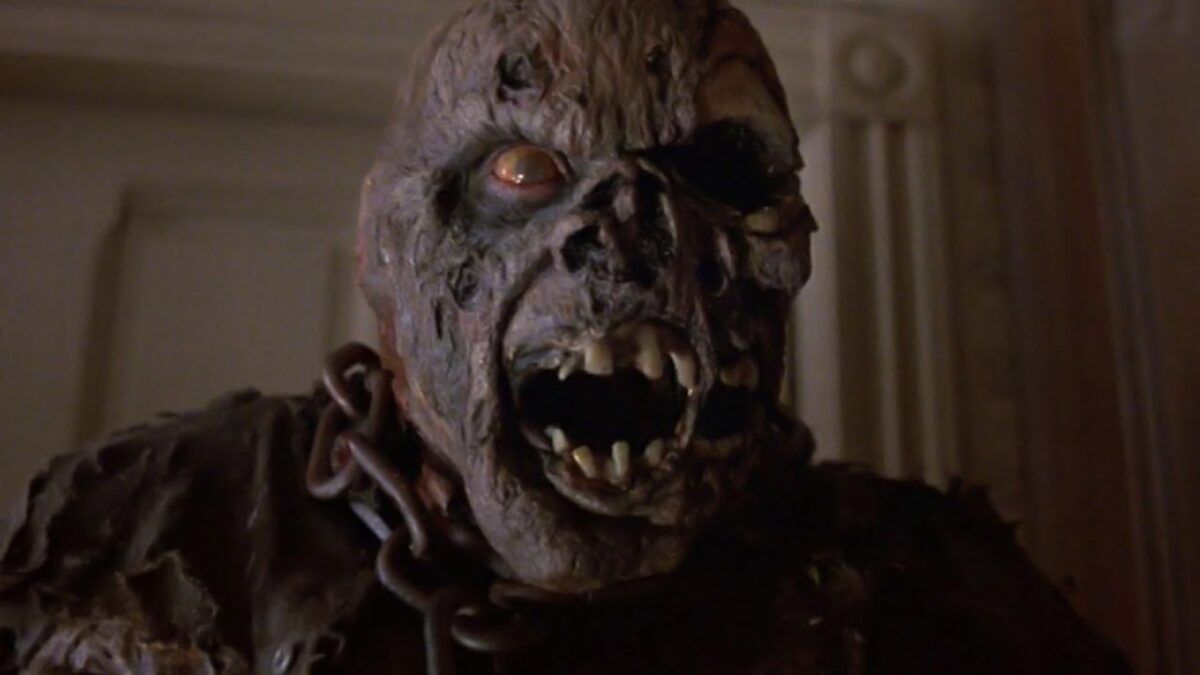
So, what were you gonna be when you grew up?
Ironically, bad box office healed Tommy Jarvis’ mind and resurrected Jason’s body. Paramount and Georgetown Pictures contrived to reboot Tommy as an entirely different character, while also simply labeling the next film Part VI. Conveniently aided by a breakdown in communication between the producers and John Shepherd’s agent, they hired Thom Matthews to play Tommy No. 3.
Pivoting to a cleaner, not meaner, conception offers less outright surrealism than any other entry and something more like pragmatic nonsense, at least if one takes Part VI: Jason Lives! (1986) as a standalone or even a direct sequel to The Final Chapter that ignores A New Beginning. But you know by now we’re not here for that.
Though he hated the previous chapter and was pressed by Paramount and Georgetown to ignore it, Jason Lives! director Thom McLaughlin nevertheless started out by restaging Part V’s opening dream. In A New Beginning, Corey Feldman’s Tommy hikes through the forest in a raging storm to a cemetery where he witnesses two grave robbers exhume Jason, who naturally dispatches them and then turns his gaze on terrified Feldman-Tommy, thus jolting Shepherd’s Tommy awake and into existence. McLaughlin opens Part VI with Matthews-as-Tommy now playing the grave robber, as if witnessed by his younger self. He plans to destroy Jason’s corpse but fails to account for the storm that resurrects Jason with a bolt of lightning. He then spends the rest of the movie pleading with the typically useless police force to do something about the monster he should have left alone. Meanwhile, of course, Jason knocks off a series of hastily introduced randos on the way to his preferred prey at a summer camp. This allows Part IV’s child-Tommy archetype (previously displaced to Reggie the Reckless) to be multiplied across a wholesome flock of pre-teen campers in peril.
As if allegorizing the plight of producers who enjoy the cash Jason rakes in while feeling professionally shamed by their disreputable creation, Tommy becomes an apologetic Dr. Frankenstein trying to stop the embarrassing monster he has unleashed. Thom Matthews plays Tommy as well-meaning and earnest, but also ridiculous: while this Boy Scout would definitely go to the cops upon accidentally awakening the undead, he’s just not tortured enough to have dug up Jason in the first place. While accepting both of these divergent Tommys spikes the series with another jolt of dreamy illogic, doing so also summons a rare and ironic eruption of the rational. If it’s true that nightmares drove Matthews’s Tommy to dig up his old tormentor/victim and unwittingly summon that lightning bolt, in dreams he must be the unhinged Shepherd-Tommy of Part V.
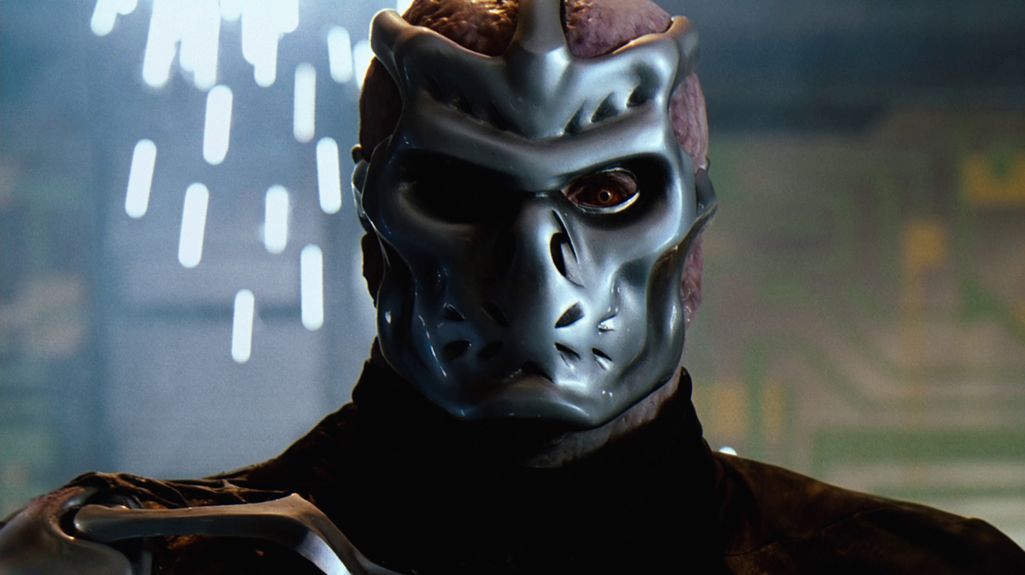
His unique ability to regenerate lost and damaged tissue, it just cries out for more research.
“Are you the director?” a professorial stranger asked Tom McLaughlin one night after the performance of a play he had directed. The man went on, “I noticed on your credits that you did one of the Friday the 13th movies.” McLaughlin stammered customary excuses for his involvement, but the man replied, “I didn’t see the movie, but I just wanted to thank you.” McLaughlin says he “was stunned for a second, and then I asked, ‘Why?’ He says, ‘Well, I’m a psychologist and we have a clinic up here in San Francisco where we work with disturbed kids. We have them put on these Jason masks and they take out their aggressions on stuffed dummies. By not being themselves and venting what they feel through this character, we’ve had a lot of wonderful breakthroughs. I just wanted to thank whoever is responsible for this.’”
I do not wish to suggest or endorse any therapeutic dimensions to franchise surrealism. I neither possess the expertise, nor is a therapeutic dimension at the heart of my love for these films or for cinema in general. However, McLaughlin’s story speaks to the forces that the many makers of the series tap into unconsciously while very consciously tapping into our wallets. This obtains for all commercial cinema, naturally, but experiencing the franchised dreamlife of so many narrative and audiovisual associations, arrived at by stochastic and irrational forces over so many movies and springing from so many minds, confronts the mysteries and treacheries of our images within ourselves, our pleasures, and our political economies.
As a Final Boy, Tommy Jarvis’ confrontations with Jason and his dream connections to other characters over the previous movies also accomplishes a few of the many and twisted gender-reversals Carol Clover works through in Men, Women, and Chainsaws (1992), where she famously conceptualizes the Final Girl. Too often treated as a simple, recurring trope in the slasher genre, Clover’s Final Girl functions more like a deep well of gender codes and identifications to which horror filmmakers cannot help returning. Fully situating this Final Boy within Clover’s schema could easily branch off into its own essay. Suffice it to say, the multi-film recursions, references, and relationships to Jason bound up in Tommy Jarvis generate what Clover describes as a text that, “at every level presents us with hermaphroditic constructions — constructions that draw attention to themselves and demand to be taken on their own terms.” Or, as once and future and ex- and ur-surrealist Georges Bataille described in The Solar Anus (1931), “without knowing it, he suffers from the mental darkness that keeps him from screaming that he himself is the girl who forgets his presence while shuddering in his arms.”
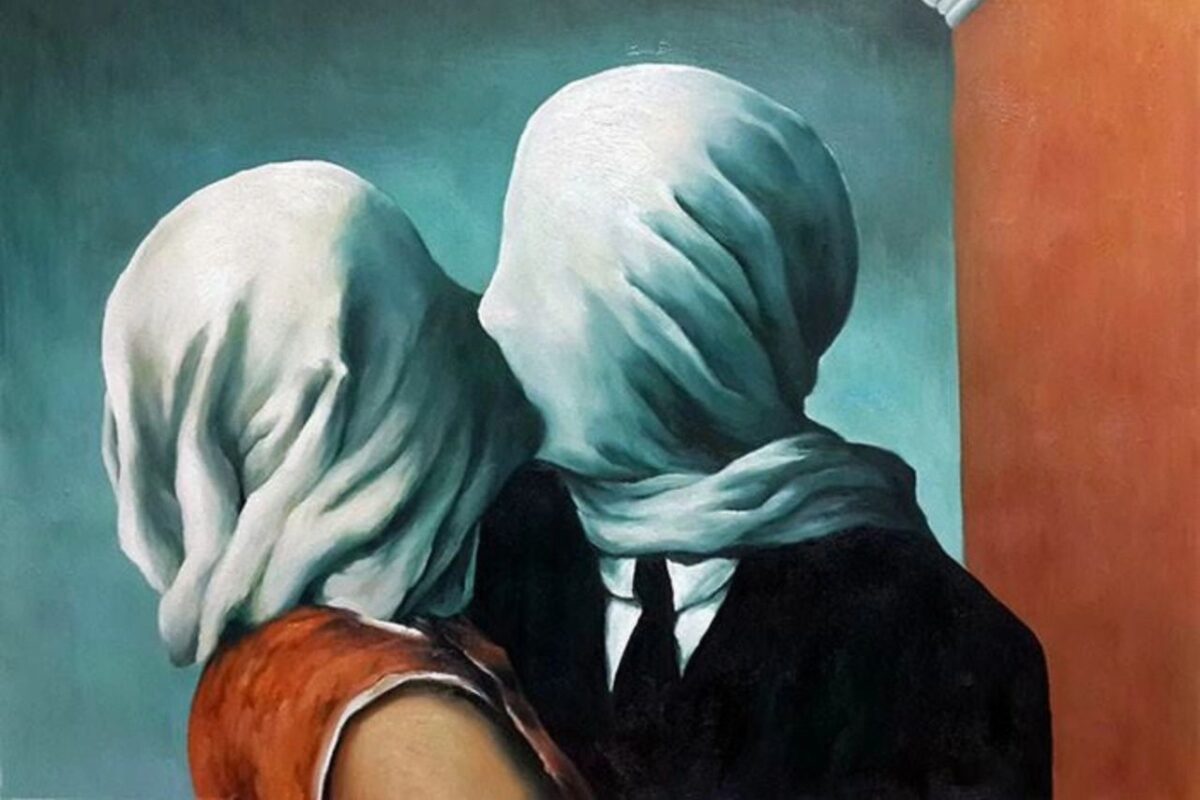
Boy/girl, self/other, victim/killer, perpetrator/witness, jerk/nothing, even financier/artist, all represent dualities of identification hidden, revealed, broken and unified in repeated confrontations with a stupid, meaningless mask. “Everything we see hides another thing,” René Magritte also wrote. “There is an interest in that which is hidden and which the visible does not show us. This interest can take the form of a quite intense feeling, a sort of conflict, one might say, between the visible that is hidden and the visible that is present.” Magritte deployed a distinctly deliberative, personal, and non-automatic practice of surrealism utterly unavailable to the often desperate artists depicting that simultaneous presence and absence of Jason, but in sincere tribute to all involved, I will repeat an apocryphal rumor about Magritte. He put the apple there because he wasn’t good at painting faces.
Purchase The Friday the 13th Collection on Blu-ray
Find the complete October Horror 2023 series here:
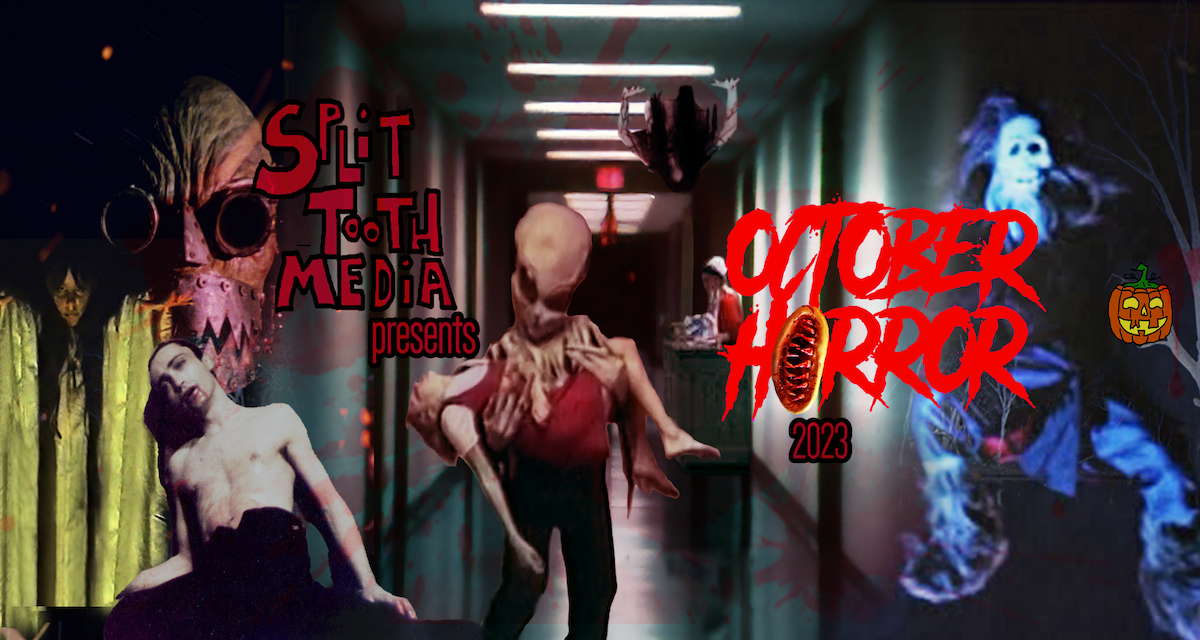
Stay up to date with all things Split Tooth Media
(Split Tooth may earn a commission from purchases made through affiliate links on our site.)

